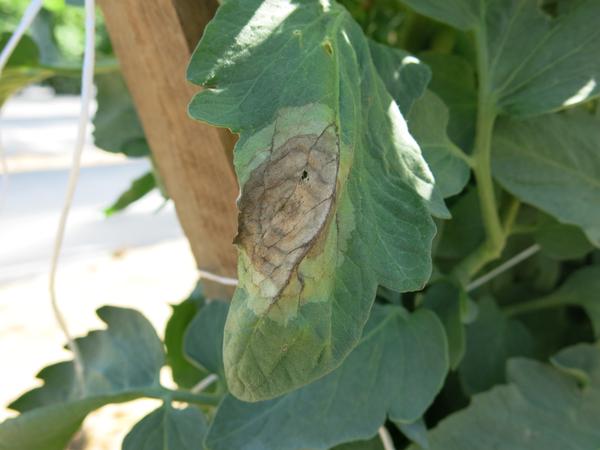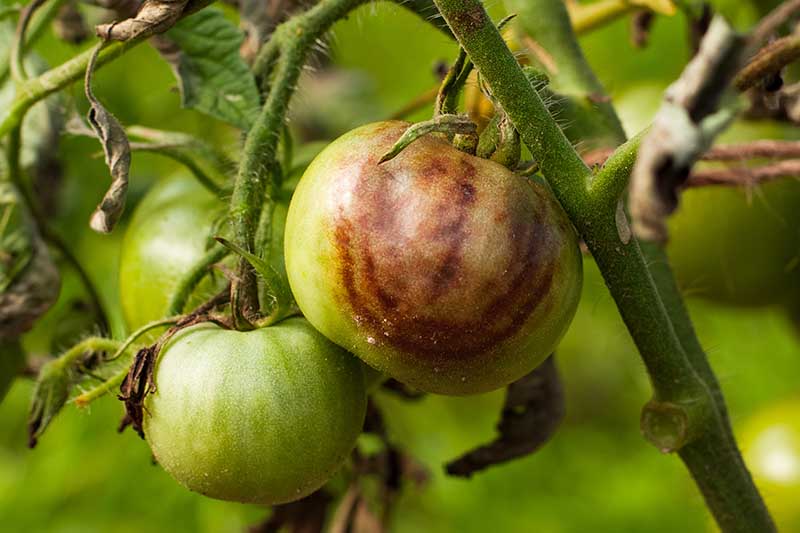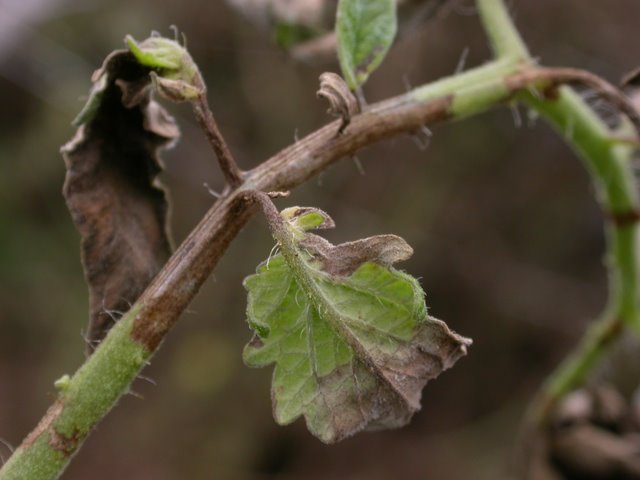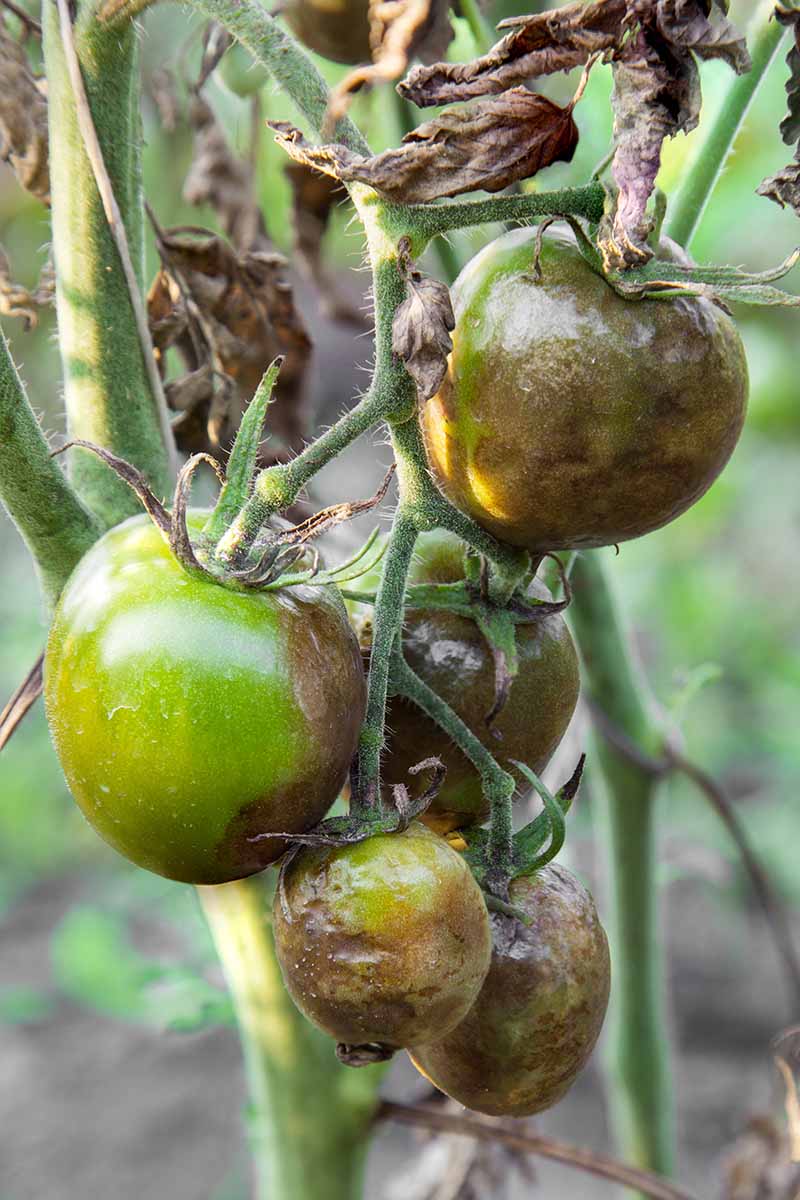
Phytophthora
WHAT IS AND HOW TO ELIMINATE
Late Blight
Phytophthora Infestans
Pathogen:
Oomycete
Type:
Risk to the plant:
CRITICAL



DESCRIPTION
WHO CAUSES IT?
Phytophthora infestans is an oomycete belonging to the class Oomycetes, known to cause late blight in tomato and potato crops. This pathogen is responsible for one of the most destructive diseases in these crops. Its reproduction is both sexual and asexual, which allows it a great capacity for adaptation and survival. Under favorable humidity and temperature conditions, sporangiospores are released and transported by wind or water to susceptible plants. Once in contact with the plant tissue, the spores germinate and penetrate the plant, developing mycelia that invade the internal tissues. Phytophthora infestans can survive in infected crop residues, soil and tubers, which facilitates its dispersal and persistence in the agricultural environment.
SYMPTOMS
Late blight caused by Phytophthora infestans severely affects tomato crops, manifesting itself in various symptoms that deteriorate both the plant and the fruit. This disease causes watery, necrotic Taches on leaves, stems and fruits, which eventually become covered with white mold in high humidity conditions. The rapid spread of spores can lead to complete destruction of the crop if not controlled in time.
- Dark, watery Taches on leaves and stems
- Necrotic lesions with a pale green or yellowish border
- White mold on the underside of leaves in humid conditions
- Withering and collapse of the plant
- Brown Taches on the fruits, which can become firm and leathery
- Premature fall of leaves and fruits
- Total loss of performance in severe infections




TEMPERATURE AND HUMIDITY
15-25°C
85-100%

HOW IS IT SPREAD?
Direct contact with infected plants, contaminated irrigation water, contaminated agricultural tools, wind, infested soil, infected plant remains

HOW TO REMOVE IT?
Home remedies
There are no home treatments
Chemical treatments
• CAPTAN 47.5% [SC] P/V
• CAPTAIN 80% [WG] P/P
• FOSETIL 31% + Propamocarb 53% [SL] P/V
• FOSETIL-AL 80% [WG] P/P
• FOSETIL-AL 80% [WP] P/P
• POTASSIUM PHOSPHONATES 25.5% (Exp. as phosphorous acid) + AZOXYSTROBIN 6.25% [SC] P/V
• POTASSIUM PHOSPHONATES 51% (Exp. as phosphorous acid) [SL] P/V
• CUPRIC HYDROXIDE 50% (EXPR. IN CU) [WG] P/P
• CUPRIC HYDROXIDE 50% (EXPR. IN CU) [WP] P/P
• METALAXIL 25% [WP] P/P
• COPPER OXYCHLORIDE (Exp. in Cu) 52% [SC] P/V
• COPPER OXYCHLORIDE 14% (exp. in Cu) + CUPRIC HYDROXIDE 14% (exp. in Cu) [WG] P/P
• COPPER OXYCHLORIDE 25% (EXPR. IN CU) [WG] P/P
• COPPER OXYCHLORIDE 30% (EXPR. IN CU) [WP] P/P
• COPPER OXYCHLORIDE 35% (exp. in Cu) [WG] P/P
• COPPER OXYCHLORIDE 35% (exp. in Cu) [WP] P/P
• COPPER OXYCHLORIDE 35% (EXPR. IN CU) [WG] P/P
• COPPER OXYCHLORIDE 38% (EXPR. IN CU) [SC] P/V
• COPPER OXYCHLORIDE 50% (EXPR. IN CU) [WG] P/P
• COPPER OXYCHLORIDE 50% (EXPR. IN CU) [WP] P/P
• COPPER OXYCHLORIDE 52% (EXPR. IN CU) [SC] P/V
• CUPROUS OXIDE 50% (EXPR. IN CU) [WP] P/P
• PROPAMOCARB 60.5% (c. hydrochloride) [SL] P/V
• PROPAMOCARB 60.7% (as hydrochloride) [SL] P/V
• CUPROCALCIC SULFATE 12.4% (EXPR. IN CU) [SC] P/V
• CUPROCALCIC SULFATE 20% (EXPR. IN CU) [WG] P/P
• CUPROCALCIC SULFATE 20% (EXPR. IN CU) [WP] P/P
Authorized treatments in organic farming
• CUPRIC HYDROXIDE 50% (EXPR. IN CU) [WG] P/P
• CUPRIC HYDROXIDE 50% (EXPR. IN CU) [WP] P/P
• COPPER OXYCHLORIDE (Exp. in Cu) 52% [SC] P/V
• COPPER OXYCHLORIDE 14% (exp. in Cu) + CUPRIC HYDROXIDE 14% (exp. in Cu) [WG] P/P
• COPPER OXYCHLORIDE 25% (EXPR. IN CU) [WG] P/P
• COPPER OXYCHLORIDE 30% (EXPR. IN CU) [WP] P/P
• COPPER OXYCHLORIDE 35% (exp. in Cu) [WG] P/P
• COPPER OXYCHLORIDE 35% (exp. in Cu) [WP] P/P
• COPPER OXYCHLORIDE 35% (EXPR. IN CU) [WG] P/P
• COPPER OXYCHLORIDE 38% (EXPR. IN CU) [SC] P/V
• COPPER OXYCHLORIDE 50% (EXPR. IN CU) [WG] P/P
• COPPER OXYCHLORIDE 50% (EXPR. IN CU) [WP] P/P
• COPPER OXYCHLORIDE 52% (EXPR. IN CU) [SC] P/V
• CUPROUS OXIDE 50% (EXPR. IN CU) [WP] P/P
• CUPROCALCIC SULFATE 12.4% (EXPR. IN CU) [SC] P/V
• CUPROCALCIC SULFATE 20% (EXPR. IN CU) [WG] P/P
• CUPROCALCIC SULFATE 20% (EXPR. IN CU) [WP] P/P
Insect allies
EFFECTIVE PRODUCTS TO ELIMINATE THIS PEST
Sponsored link
Sponsored link
Sponsored link
Sponsored link
Sponsored link
Sponsored link
Effective against all types of fungi
- Carry out an appropriate crop rotation, avoiding planting tomatoes in the same place consecutively.
- Use tomato varieties resistant to late blight.
- Apply preventive and contact fungicides regularly, especially in periods of high humidity.
- Maintain an adequate distance between plants to improve air circulation and reduce leaf humidity.
- Remove and destroy remains of infected plants at the end of each growing cycle.
- Implement good drainage in the soil to avoid waterlogging.
- Regularly monitor the crop to detect symptoms early and apply control measures.
- Avoid sprinkler irrigation that can favor the spread of the pathogen.
























